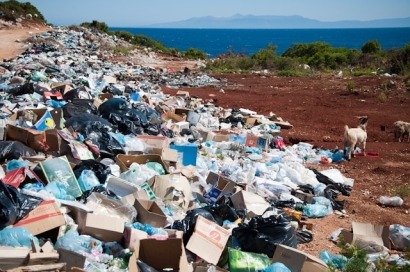
Efforts are underway to find new ways to repurpose materials that humans typically discard. It may be the raw material necessary to generate a new form of renewable energy. While still a novel pursuit, it presents a promising solution that hits two birds with one stone — addressing pollution by using it to produce electricity while simultaneously lowering carbon emissions, creating a full-circle effect.
A catalyst speeds up a chemical reaction, remaining unchanged in the process. Waste-derived catalysts come from materials that would otherwise end up in landfills. Instead of letting them pile up, scientists turn them into powerful tools that help produce clean energy.
There are three types of waste-derived catalysts.
Municipal solid waste alone generates more than 2 billion metric tons yearly, and over 10 thousand tons enter landfills daily. Using waste in this manner inevitably reduces the quantity of trash disposed of in landfills or incinerated.
Air, water and plastic pollution are among the most significant problems festering the Earth today. Scientists are developing methods to capture pollutants and convert them into green energy catalysts.
Polluted air affects 99% of the world’s population and was responsible for 8.1 million deaths in 2021.
Industrial CO2 capture is one way to address carbon-related air pollution. Factories can process their emissions into catalysts that enhance chemical reactions in biofuel production. Scientists are repurposing carbon dioxide into nanomaterials for use in battery and hydrogen fuel technologies.
In 2022, the World Health Organization revealed that 1.7 billion people use feces-contaminated drinking water sources, highlighting the urgent need for better water management beyond purification.
Even polluted water can become a green energy resource. Extracting heavy metals from industrial wastewater allows people to use them in photocatalytic water-splitting to generate hydrogen fuel. It’s also possible to repurpose contaminants in sewage as part of bioelectrochemical systems that generate electricity.
Plastic waste is one of the most persistent pollutants. Up to 199 million tons of plastic waste cover the world’s oceans. However, recent innovations have found ways to convert non-recyclables into catalysts for biofuel production. Pyrolysis can convert 60% to 80% of plastic waste into liquid fuels, offering a more sustainable waste-to-energy generation model.
Global CO2 emissions reached a record high of 37.41 billion metric tons in 2024. This gas supercharges the natural greenhouse effect and made the year the warmest ever on record, being over 1.5 degrees Celsius above the 1900 average.
The most impressive breakthrough in renewable energy — carbon nanoparticles synthesis — is a promising offense against a warming world. This process turns carbon from pollution sources like CO2 emissions or plastic waste into microscopic particles that improve energy efficiency by speeding up energy production in hydrogen fuel cells and solar panels.
However, while the potential is immense, system failures remain a concern, particularly in industrial applications where hydraulic systems are vital.
Hydraulic system failures — caused by fluid contamination, leaks or pressure inconsistencies — can disrupt the efficiency of renewable energy technologies that rely on precise mechanical operations, such as wind turbines and hydroelectric power plants. Researchers are now exploring carbon nanoparticles as additives in hydraulic fluids to enhance lubrication, reduce wear and improve thermal stability, potentially preventing breakdowns and extending the life span of critical components.
There are several applications of carbon nanoparticles.
Converting pollution to energy sources offers a range of significant advantages, benefiting the environment and the economy.
Repurposing solid and industrial waste into catalysts can minimize landfill usage, decrease ocean plastic pollution and mitigate toxic emissions, contributing to a cleaner planet and healthier ecosystems.
Many renewable energy processes, such as solar energy storage and hydrogen production, require catalysts to function efficiently. Waste-derived catalysts provide a cost-effective and sustainable alternative to traditional materials, making renewable energy production more viable at a larger scale. Solar power generators are increasingly affordable and accessible. Experts predict solar will account for 80% of the growth in global renewable capacity by 2030. Spent catalysts could drive that figure sooner than anticipated.
Recycling industrial byproducts into catalysts eliminates the need for expensive raw materials, lowering production costs in green energy sectors. Renewable energy sources are now more accessible and competitive with fossil fuels.
Repurposing waste for energy applications aligns with circular economy principles. Continuously reusing resources instead of discarding them reduces dependency on raw material extraction and minimizes environmental degradation.
Waste-derived catalysts are critical in slowing climate change by reducing carbon emissions and providing cleaner alternatives to fossil fuels. Converting pollution to energy solutions curbs greenhouse gas emissions and promotes sustainable energy independence.
The integration of waste-to-energy catalysts is gaining momentum worldwide, with governments and corporations investing in research and large-scale implementation. As technology advances, more waste streams will enhance renewable energy and sustainability. The next decade could see groundbreaking changes, including:
The idea of converting pollution into renewable energy catalysts is becoming a reality for a cleaner future. This revolutionary step toward sustainability helps reduce waste, lower energy costs and enhance clean electricity production. As research and investment continue to grow, waste-derived catalysts have the potential to completely reimagine how we view waste — from trash to treasure.
By advancing these technologies, humanity moves closer to a world where pollution becomes part of the solution, paving the way for a more sustainable and energy-efficient future.

